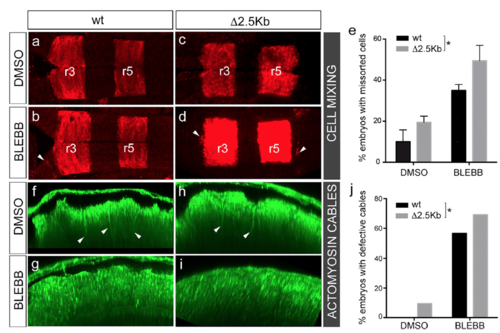Fig. S7
|
Functional role of redundant enhancers upon stress conditions. Embryos were placed under stress conditions by incubating them at 14 hpf with paranitroblebbistatin (BLEBB) to disrupt the actomyosin cables or DMSO as a control. Embryos were grown until 18–20 hpf, and the effect in the rhombomeric cell mixing and in the disruption of actomyosin cables was scored. (A–D) Rhombomeric cell-mixing phenotype assessed by in situ hybridization with egra2. Dorsal views of WT (wt; A and B) or CRISPR-Δ2.5kb homozygous embryos (C and D), treated with DMSO or BLEBB. Note that WT and CRISPR-Δ2.5kb homozygous embryos with compromised actomyosin cables (BLEBB) display ectopic rhombomeric cells as expected (see white arrowheads in B and D). (E) Bar plot showing the penetrance of the cell-sorting defects under the described conditions. Note that the percentage of CRISPR-Δ2.5kb embryos within the population displaying cell-sorting defects increases significantly compared with WT embryos (two-way ANOVA, *P < 0.05). These data correspond to an average of three independent experiments, in which ≥20 embryos per condition were employed. (F–I) Disruption of the actomyosin cables assessed by using homozygous embryos derived from Tg[CRISPR-Δ2.5kb;myosinII:GFP] heterozygous crosses. Sagittal views showing the actomyosin cable integrity in WT (F and G) or CRISPR- Δ2.5kb homozygous embryos (H and I), either treated with DMSO or BLEBB. (J) Bar plot showing the penetrance of the actomyosin cable defects under the described conditions. Note that the percentage of CRISPR-Δ2.5kb embryos within the population displaying defects in the actomyosin structures increases significantly compared with WT embryos. Statistical analysis was performed using a χ2 test (*P < 0.04). Note that para-nitroblebbistatin efficiency is ∼50% as previously described (16). |

